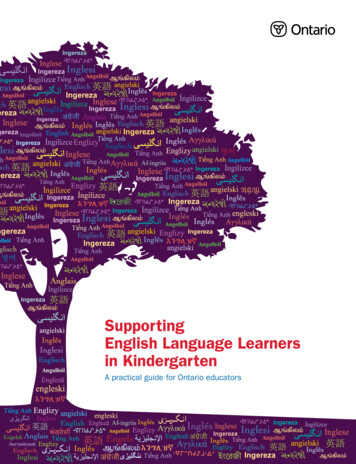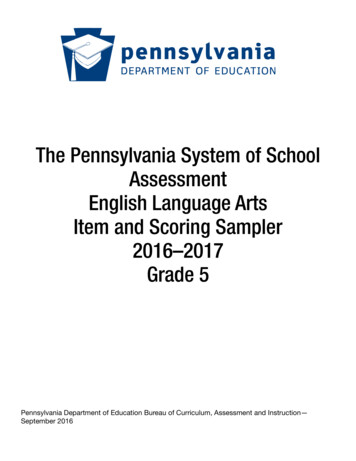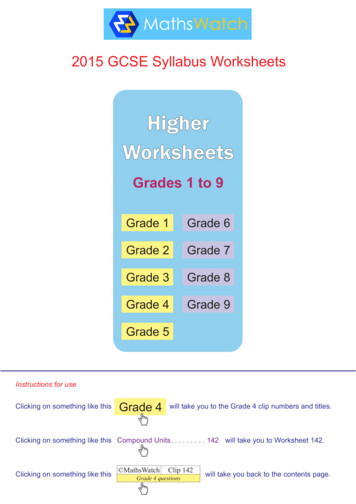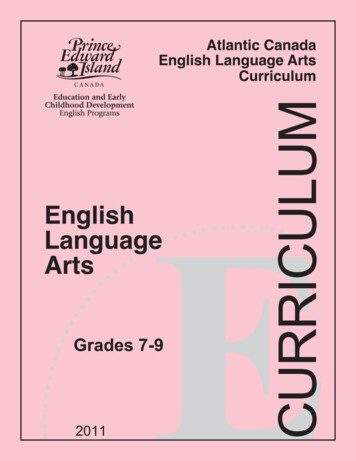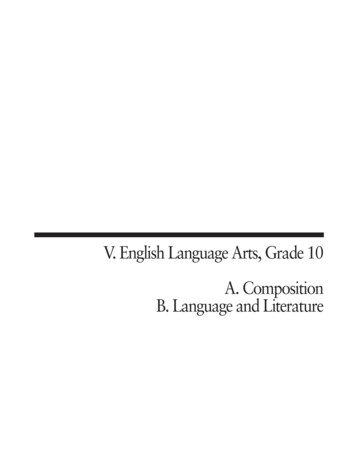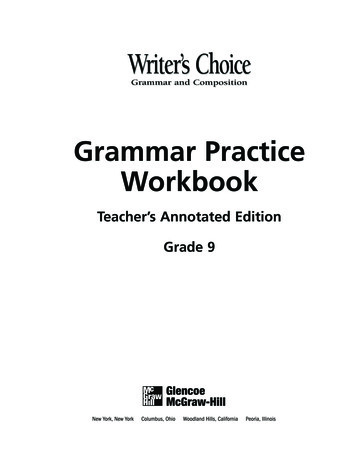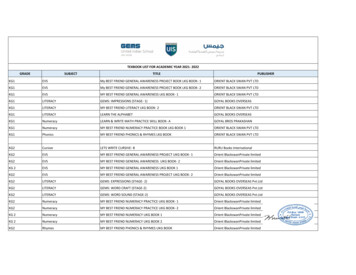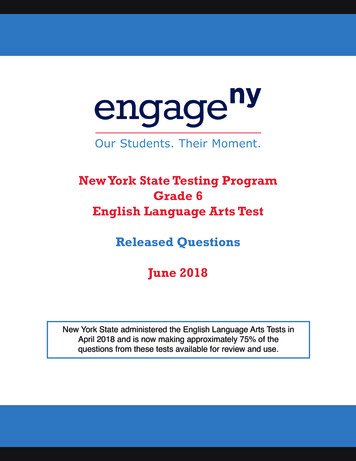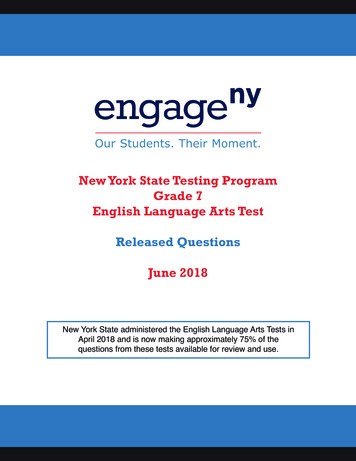
Transcription
New York State Testing ProgramGrade 7English Language Arts TestReleased QuestionsJune 2018New York State administered the English Language Arts Tests inApril 2018 and is now making approximately 75% of thequestions from these tests available for review and use.
THE STATE EDUCATION DEPARTMENT / THE UNIVERSITY OF THE STATE OF NEW YORK / ALBANY, NY 12234New York State Testing ProgramGrades 3–8 English Language ArtsReleased Questions from 2018 ExamsBackgroundIn 2013, New York State began administering tests designed to assess student performance in accordancewith the instructional shifts and rigor demanded by the new New York State P-12 Learning Standards inEnglish Language Arts (ELA). To help in this transition to new assessments, the New York State EducationDepartment (SED) has been releasing an increasing number of test questions from the tests that wereadministered to students across the State in the spring. This year, SED is again releasing large portionsof the 2018 NYS Grades 3–8 English Language Arts and Mathematics test materials for review, discussion,and use.For 2018, included in these released materials are at least 75 percent of the test questions that appearedon the 2018 tests (including all constructed-response questions) that counted toward students’ scores.Additionally, SED is providing information about the released passages; the associated text complexity foreach passage; and a map that details what learning standards each released question measures and thecorrect response to each question. These released materials will help students, families, educators, and thepublic better understand the tests and the New York State Education Department’s expectations forstudents.Understanding ELA QuestionsMultiple-Choice QuestionsMultiple-choice questions are designed to assess the New York State P-12 Learning Standards in EnglishLanguage Arts. These questions ask students to analyze different aspects of a given text, including centralidea, style elements, character and plot development, and vocabulary. Almost all questions, includingvocabulary questions, will be answered correctly only if the student comprehends and makes use of thewhole passage.For multiple-choice questions, students select the correct response from four answer choices. Multiplechoice questions assess reading standards in a variety of ways. Some ask students to analyze aspects of textor vocabulary. Many questions require students to combine skills. For example, questions may ask studentsto identify a segment of text that best supports the central idea. To answer these questions correctly, astudent must first comprehend the central idea and then show understanding of how that idea is supported.Questions tend to require more than rote recall or identification.Short-Response QuestionsShort-response questions are designed to assess New York State P-12 Reading and Language Standards.These are single questions in which a student uses textual evidence to support his or her answer to aninferential question. These questions ask the student to make an inference (a claim, position, or conclusion)
based on his or her analysis of the passage, and then provide two pieces of text-based evidence to supporthis or her answer.The purpose of the short-response questions is to assess a student’s ability to comprehend and analyzetext. In responding to these questions, students are expected to write in complete sentences. Responsesrequire no more than three complete sentences. The rubric used for evaluating short-response questionscan be found in the grade-level Educator Guides at sh-language-arts-and-mathematics.Extended-Response QuestionsExtended-response questions are designed to measure a student’s ability to write from sources. Questionsthat measure Writing from Sources prompt students to communicate a clear and coherent analysis of oneor two texts. The comprehension and analysis required by each extended response is directly related tograde-specific reading standards. Student responses are evaluated on the degree to which they meet gradelevel writing and language expectations. This evaluation is made by using a rubric that incorporates thedemands of grade-specific New York State P-12 Reading and Language standards.The integrated nature of the standards for ELA and literacy requires that students are evaluated across thestrands (Reading, Writing, and Language) with longer pieces of writing, such as those prompted by theextended-response questions. The rubric used for evaluating extended-response questions can be found inthe grade-level Educator Guides at ish-languagearts-and-mathematics.New York State P-12 Learning Standards AlignmentThe alignment(s) to the New York State P-12 Learning Standards for English Language Arts is/are intendedto identify the analytic skills necessary to successfully answer each question. However, some questionsmeasure proficiencies described in multiple standards, including writing and additional reading andlanguage standards. For example, two-point and four-point constructed-response questions requirestudents to first conduct the analyses described in the mapped standard and then produce writtenresponses that are rated based on writing standards. To gain greater insight into the measurement focusfor constructed-response questions, please refer to the rubrics.These Released Questions Do Not Comprise a “Mini Test”To ensure future valid and reliable tests, some content must remain secure for possible use on futureexams. As such, this document is not intended to be representative of the entire test, to show howoperational tests look, or to provide information about how teachers should administer the test; rather, itspurpose is to provide an overview of how the test reflects the demands of the New York State P-12 LearningStandards.The released questions do not represent the full spectrum of the standards assessed on the State tests, nordo they represent the full spectrum of how the standards should be taught and assessed in the classroom.It should not be assumed that a particular standard will be measured by an identical question in futureassessments. Specific criteria for writing test questions, as well as additional assessment information, areavailable at http://www.engageny.org/common-core-assessments.
2018 Grade 7 ELA Test Text Complexity Metrics forReleased Questions Available on EngageNYSelecting high-quality, grade-appropriate passages requires both objective textcomplexity metrics and expert judgment. For the Grades 3–8 assessments based on theNew York State P-12 Learning Standards for English Language Arts, both quantitativeand qualitative rubrics are used to determine the complexity of the texts and theirappropriate placement within a grade-level ELA exam.Quantitative measures of text complexity are used to measure aspects of textcomplexity that are difficult for a human reader to evaluate when examining a text.These aspects include word frequency, word length, sentence length, and text cohesion.These aspects are efficiently measured by computer programs. While quantitative textcomplexity metrics are a helpful start, they are not definitive.Qualitative measures are a crucial complement to quantitative measures. Usingqualitative measures of text complexity involves making an informed decision about thedifficulty of a text in terms of one or more factors discernible to a human readerapplying trained judgment to the task. To qualitatively determine the complexity of atext, educators use a rubric composed of five factors; four of these factors are requiredand one factor is optional. The required criteria are: meaning, text structure, languagefeatures, and knowledge demands. The optional factor, graphics, is used only if agraphic appears in the text.To make the final determination as to whether a text is at grade-level and thusappropriate to be included on a Grades 3–8 assessment, New York State uses a two-stepreview process, which is an industry best-practice. First, all prospective passagesundergo quantitative text complexity analysis using three text complexity measures. Ifat least two of the three measures suggest that the passage is grade-appropriate, thepassage then moves to the second step, which is the qualitative review using the textcomplexity rubrics. Only passages that are determined appropriate by at least two ofthree quantitative measures of complexity and are determined appropriate by thequalitative measure of complexity are deemed appropriate for use on the exam.For more information about text selection, complexity, and the review process pleaserefer lexity-grades-9-12
Degrees ofReading Power*Flesch-KincaidNeed Those ZZZZZs Young Night Owls StillRequire Plenty of SleepExcerpt from "A Man's Cup" from Childrenof the LonghouseExcerpt from The Statue of LibertyExcerpt from Something Fishy Is Going On,Everyone!Excerpt from Behind the MountainsExcerpt from Little CricketWordCount774LexilePassage TitleReading MaturityMetric*Text Complexity Metrics for 2018 Grade 7 0-11007.66.85756AppropriateAppropriate* Depending on when the passage was selected, either the Reading Maturity Metric or Degrees of Reading Power wasused as the third quantitative metric.New York State 2018 Quantitative Text Complexity Chart for Assessment and CurriculumTo determine if a text’s quantitative complexity is at the appropriate grade level, NewYork State uses the table below. In cases where a text is excerpted from a large work,only the complexity of the excerpt that students see on the test is measured, not thelarge work, so it is possible that the complexity of a book might be above or below gradelevel, but the text used on the assessment is at grade level. Because the measurementof text complexity is inexact, quantitative measures of complexity are defined by gradeband rather than by individual grade level and then paired with the qualitative review byan �10th11th–12thATOS2.75 – 5.144.97 – 7.037.00 – 9.989.67 – 12.0111.20 – 14.10Degrees ofReadingPower42 – 5452 – 6057 – 6762 – 7267 – 74Source: Student Achievement PartnersFlesch-Kincaid1.98 – 5.344.51 – 7.736.51 – 10.348.32 – 12.1210.34 – 14.20The LexileFramework420 – 820740 – 1010925 – 11851050 – 13351185 – 1385ReadingMaturity3.53 – 6.135.42 – 7.927.04 – 9.578.41 – 10.819.57 – 12.00SourceRater0.05 – 2.480.84 – 5.754.11 – 10.669.02 – 13.9312.30 – 14.50
Released Questions
Session 1TIPS FOR TAKING THE TESTHere are some suggestions to help you do your best: Be sure to read all the directions carefully. ost questions will make sense only when you read the whole passage. You may readMthe passage more than once to answer a question. When a question includes a quotationfrom a passage, be sure to keep in mind what you learned from reading the wholepassage. You may need to review both the quotation and the passage in order to answerthe question correctly. Read each question carefully and think about the answer before making your choice.Session 1Page 1
91011121314151617Page 14GO ONSession 1
18192021GO ONSession 1Page 15
15ABCD16ABCD17ABCDPage 16GO ONSession 1
18ABCD19ABCD20ABCDGO ONSession 1Page 17
21ABCDPage 18GO ONSession 1
678910111213141516Page 20GO ONSession 1
1718GO ONSession 1Page 21
22ABCD23ABCD24ABCDPage 22GO ONSession 1
25ABCD26ABCD27ABCDGO ONSession 1Page 23
28ABCDPage 24GO ONSession 1
6789Page 26GO ONSession 1
1011GO ONSession 1Page 27
29ABCD30ABCDPage 28GO ONSession 1
31ABCD32ABCDGO ONSession 1Page 29
33ABCD34ABCDPage 30GO ONSession 1
35ABCDSTOPSession 1Page 31
Released Questions
Excerpt from “Something Fishy Is Going On, Everyone!” by Dave Canavan: 3plearning.com, 3P Learning, WEB Aug. 16, 2014, 2:43pm. -on-everyone/ . Used by permission.Excerpt from “Behind the Mountains” by Edwidge Danticat. Copyright 2002 Scholastic, Inc. Used by permission.Excerpt from “Little Cricket” by Jackie Brown. Copyright 2004 by Jackie Brown. First published by Hyperion Books for Children, animprint of Disney Book Group, LLC. Used by permission.Developed and published under contract with the New York State Education Department by Questar Assessment Inc., 5550 Upper 147thStreet West, Minneapolis, MN 55124. Copyright 2018 by the New York State Education Department.Session 2
Session 2TIPS FOR TAKING THE TESTHere are some suggestions to help you do your best: Be sure to read all the directions carefully. ost questions will make sense only when you read the whole passage. You may readMthe passage more than once to answer a question. When a question includes a quotationfrom a passage, be sure to keep in mind what you learned from reading the wholepassage. You may need to review both the quotation and the passage in order to answerthe question correctly. Read each question carefully and think about the answer before writing your response. In writing your responses, be sure to– clearly organize your writing and express what you have learned;– accurately and completely answer the questions being asked;– support your responses with examples or details from the text; and– write in complete sentences using correct spelling, grammar, capitalization,and punctuation. F or the last question in this test book, you may plan your writing on the Planning Pageprovided, but do NOT write your final answer on this Planning Page. Writing on thisPlanning Page will NOT count toward your final score. Write your final answer on thelined response pages provided.Session 2Page 1
5678910GO ONSession 2Page 3
1112Page 4GO ONSession 2
36GO ONSession 2Page 5
37Page 6GO ONSession 2
38GO ONSession 2Page 7
GO ONSession 2Page 9
Page 10GO ONSession 2
39GO ONSession 2Page 11
40Page 12GO ONSession 2
Page 14GO ONSession 2
GO ONSession 2Page 15
41Page 16GO ONSession 2
42GO ONSession 2Page 17
43Page 20GO ONSession 2
STOPSession 2Page 21
Grade 72018English Language Arts TestSession 2April 11 – 13, 2018
THE STATE EDUCATION DEPARTMENTQuestionTypeTHE UNIVERSITY OF THE STATE OF NEW YORK / ALBANY, NY 122342018 English Language Arts Tests Map to the StandardsReleased Questions on EngageNYGrade 7Multiple Choice Questions: Constructed Response Questions:Percentage of StudentsAverageP-ValueKey PointsStandardSubscoreWho Answered CorrectlyPoints(Average Points Earned(P-Value)Earned Total Possible Points)Session 115Multiple ple ple ple ple ple ple ple ple ple ple ple ple ple ple ple ple ple ple ple ple ChoiceC1CCSS.ELA-Literacy.RI.7.3Reading0.56
QuestionTypeKey PointsStandardSubscoreMultiple Choice Questions: Constructed Response Questions:Percentage of StudentsAverageP-ValueWho Answered CorrectlyPoints(Average Points Earned(P-Value)Earned Total Possible Points)Session 236Constructed Response2CCSS.ELA-Literacy.RI.7.6Writing to Sources1.580.7937Constructed Response2CCSS.ELA-Literacy.RI.7.5Writing to Sources1.60.8038Constructed Response2CCSS.ELA-Literacy.RI.7.5Writing to Sources1.440.7239Constructed Response2CCSS.ELA-Literacy.RL.7.3Writing to Sources1.480.7440Constructed Response2CCSS.ELA-Literacy.RL.7.2Writing to Sources1.360.6841Constructed Response2CCSS.ELA-Literacy.RL.7.4Writing to Sources1.340.6742Constructed Response2CCSS.ELA-Literacy.RL.7.6Writing to Sources1.340.6743Constructed Response4CCSS.ELA-Literacy.RL.7.3Writing to Sources2.240.56*This item map is intended to identify the primary analytic skills necessary to successfully answer each question. However, each constructed-response question measuresproficiencies described in multiple standards, including writing and additional reading and language standards. For example, two point and four point constructed-responsequestions require students to first conduct the analyses described in the mapped standard and then produce written responses that are rated based on writing standards. To gaingreater insight into the measurement focus for constructed-response questions please refer to the rubrics shown in the Educator Guides.
Grade 7 English Language Arts Test Released Questions . grade-specific reading standards. Stude nt responses are evaluated on the degree to which they meet grade - . do they represent the full spectrum of how the
